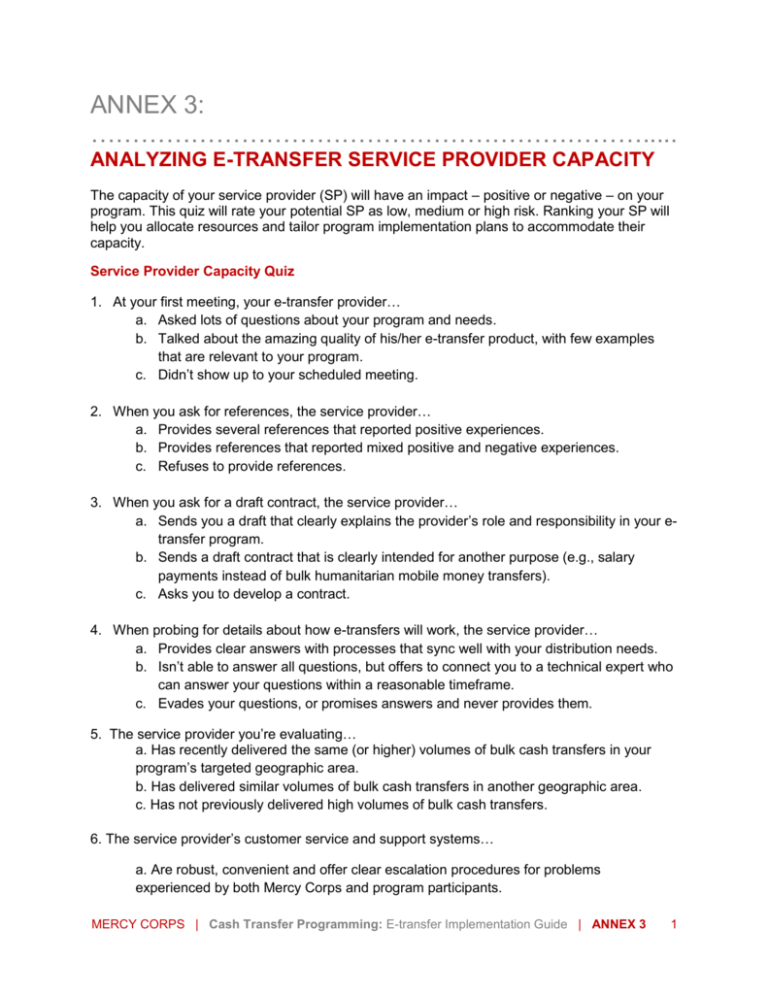3 Analyzing Service Provider Capacity FINAL
advertisement

ANNEX 3: …………………………………………………………..... ANALYZING E-TRANSFER SERVICE PROVIDER CAPACITY The capacity of your service provider (SP) will have an impact – positive or negative – on your program. This quiz will rate your potential SP as low, medium or high risk. Ranking your SP will help you allocate resources and tailor program implementation plans to accommodate their capacity. Service Provider Capacity Quiz 1. At your first meeting, your e-transfer provider… a. Asked lots of questions about your program and needs. b. Talked about the amazing quality of his/her e-transfer product, with few examples that are relevant to your program. c. Didn’t show up to your scheduled meeting. 2. When you ask for references, the service provider… a. Provides several references that reported positive experiences. b. Provides references that reported mixed positive and negative experiences. c. Refuses to provide references. 3. When you ask for a draft contract, the service provider… a. Sends you a draft that clearly explains the provider’s role and responsibility in your etransfer program. b. Sends a draft contract that is clearly intended for another purpose (e.g., salary payments instead of bulk humanitarian mobile money transfers). c. Asks you to develop a contract. 4. When probing for details about how e-transfers will work, the service provider… a. Provides clear answers with processes that sync well with your distribution needs. b. Isn’t able to answer all questions, but offers to connect you to a technical expert who can answer your questions within a reasonable timeframe. c. Evades your questions, or promises answers and never provides them. 5. The service provider you’re evaluating… a. Has recently delivered the same (or higher) volumes of bulk cash transfers in your program’s targeted geographic area. b. Has delivered similar volumes of bulk cash transfers in another geographic area. c. Has not previously delivered high volumes of bulk cash transfers. 6. The service provider’s customer service and support systems… a. Are robust, convenient and offer clear escalation procedures for problems experienced by both Mercy Corps and program participants. MERCY CORPS | Cash Transfer Programming: E-transfer Implementation Guide | ANNEX 3 1 b. Do not have clear customer service procedures, but are willing to develop them for your program. c. Do not offer clear support systems and do not seem interested in developing them. 7. When asked about protecting participant’s personal information, the service provider… a. Provides assurances, in writing, about how participant data is used, stored and protected from exploitative use. b. Takes measures to protect program participant data, but does not have them written down. c. Does not have clear data protection practices or policies. 8. When asked about agent networks and float1 management, the e-cash service provider… a. Has agents located close to program participants and has managed significant float demands in the past. b. Has not managed cash transfers at the scale you need, but has a reasonable strategy for expanding agent networks and managing float to meet your needs. c. Assures you that they can meet your needs without providing details. Answer key: If you answered mostly A’s, you’re headed in the right direction. This SP can be considered “low risk.” If you answered mostly B’s, you’re working with a “medium risk” SP. Proceed with caution and consider staffing up around SP management. Did you answer mostly C’s? Watch out! You’re dealing with a “high risk” SP. Trust your gut and consider walking away from this partnership. If you decide to work with this SP, you will need to take on an active capacity building role. We suggest hiring a full time SP liaison that can help prepare the SP for the program. This position should work closely with the SP to ensure that key processes are in place and capable of meeting program needs. Processes that are often problematic for high risk service providers include agent network management, new client (program participant) registration, reporting, liquidity management and customer service. 1 Float: The balance of physical cash that an e-cash agent can immediately access to meet customer demands to cash out electronic money. This question is only applicable to e-cash providers. MERCY CORPS | Cash Transfer Programming: E-transfer Implementation Guide | ANNEX 3 2








